“Spoon Rack” has been added to your cart.
View cart
-
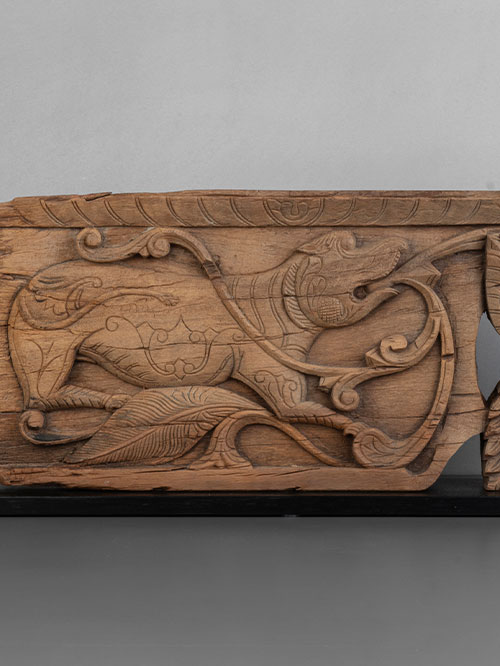
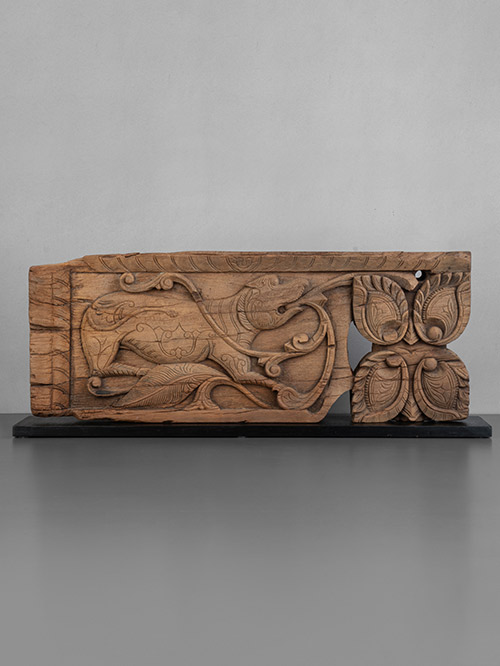
Southern India
Wood
This large decorative panel depicts a confident, prowling tiger spewing vegetation from its open jaw. The foliage forms intricate decorative swirls around the tiger, with a floral sprig positioned to its right.
Wooden construction was once widespread throughout most of Southern India, but the intense heat and the severe monsoonal rains have meant that a large proportion of the wooden buildings in private and public use have now disappeared. The typical southern Indian wooden building, was supported on a framework of columns, with an elaborate system of interlocking brackets and beams to support the floors and roofs. Carved doors, windows, and screens and panels filter light and ventilate the interiors, creating an environment that is both comfortable and richly detailed. The scale and shape of houses was dictated by the maximum height and span of timber beams, resulting in a modular system of construction. The woodwork was deeply cut and naturalistic, the intention of the artisans was to capture the forms and energies of the natural world. Panels such as these, with floral medallions radiating in full bloom or others with elaborate geometric modelling, ornamented of palaces, houses and temples.
Size (cms): 32(H) x 82.5(W) x 14.5(D)
Size (inches): 12.5(H) x 32.5(W) x 5.5(D)
-
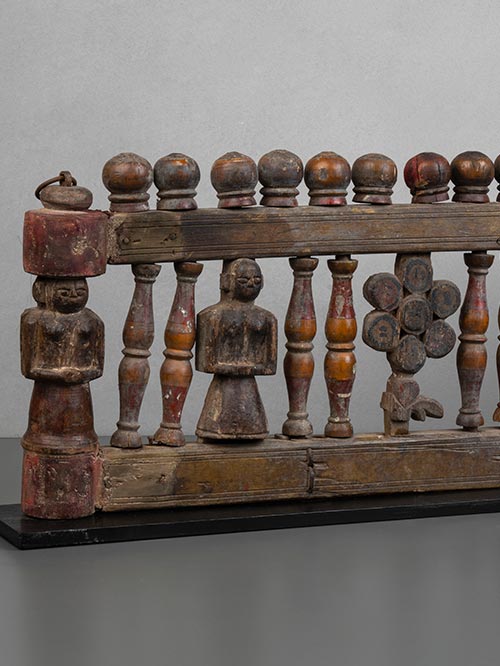
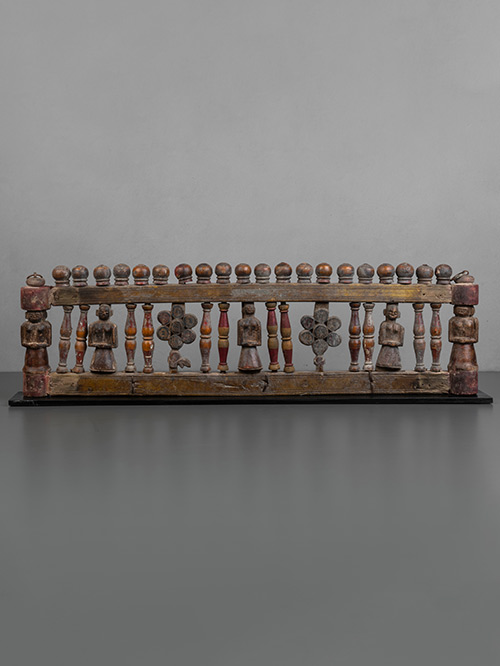
Konkan Region
Wood with polychroming
A rare cradle railing with five carved wooden fertility votive dolls, alternating with flower head sprays and turned wooden spindles.
Votive dolls, integral to folk rituals, served as devotional offerings within home shrines to the Goddess Mauli or Mariyai. Revered as a fertility deity, Mauli holds a central role in the spiritual lives of many, particularly childless women seeking her blessings. Rituals often involve adorning her image with turmeric, red kumkum, and oil, emphasising her sacredness. Known for her protective powers against devastating illnesses like smallpox and cholera, the Goddess also demands consistent devotion, as neglect is believed to provoke her anger. These offerings typically take the form of simple wooden carvings depicting women in worship, pregnant figures, mothers, or water carriers—symbolising the life and sustenance she governs.
Size (cms): 31(H) x 102(W) x 12(D)
Size (inches): 12(H) x 40(W) x 4.5(D)
-
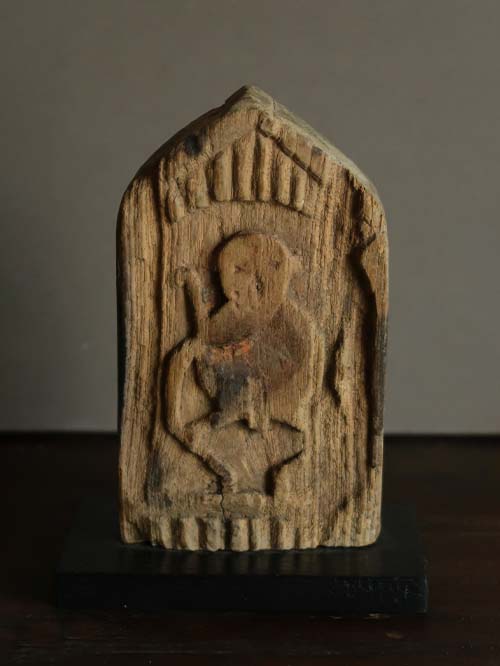
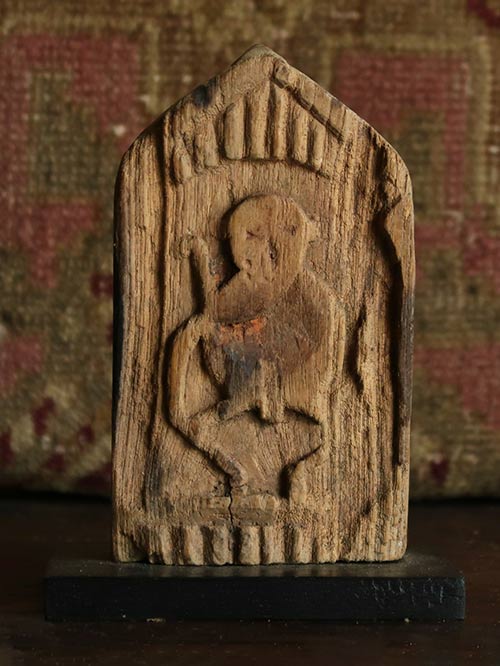
Western India
Wood
A primitive door panel with a central figure of a two-armed Ganesha. An arch frames the central figure forming a ritual throne around the deity.
Size(cms): 13.5 (H) x 10 (W) x 6.5 (D)
Size(inches): 5.3 (H) x 4 (W) x 2.5 (D)
-
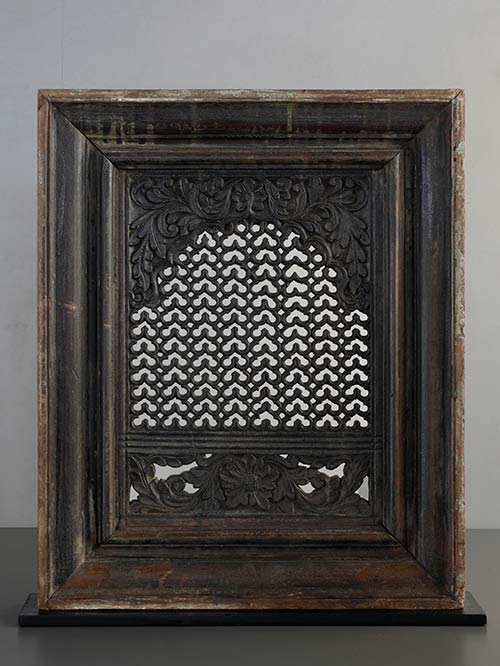

Deccan
Wood
An enchanting play of light and shadow is created from this jali or lattice window. Ideal during the hot humid Indian summer, the jalis dispel the harsh rays of the sun and allow a cool breeze to circulate indoors. Moreover, the purdah- conscious women used the jalis of their balconies and terraces to enjoy an outside view, without being seen themselves by the public.
Wooden construction was once widespread throughout most of Southern India, but the intense heat and the severe monsoonal rains have meant that a large proportion of the wooden buildings in private and public use have now disappeared. The typical southern Indian wooden building, was supported on a framework of columns, with an elaborate system of interlocking brackets and beams to support the floors and roofs. Carved doors, windows, and screens and panels filter light and ventilate the interiors, creating an environment that is both comfortable and richly detailed. The scale and shape of houses was dictated by the maximum height and span of timber beams, resulting in a modular system of construction. The woodwork was deeply cut and naturalistic, the intention of the artisans was to capture the forms and energies of the natural world.
Size (cms): 63(H) x 54(W) x 11(D)
Size (inches): 25(H) x 21.5(W) x 4.5(D)
-
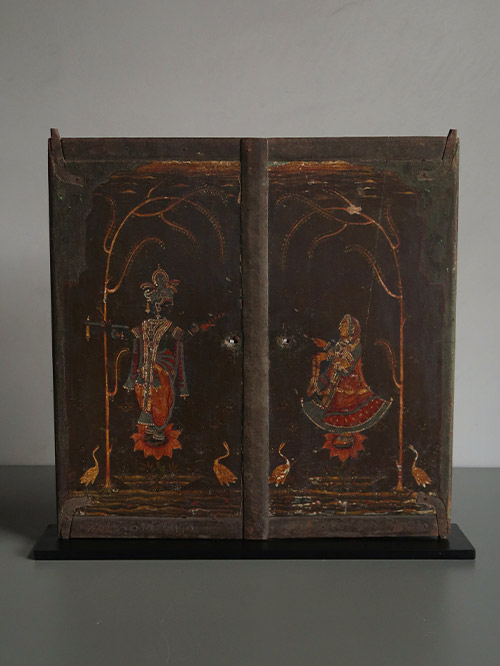
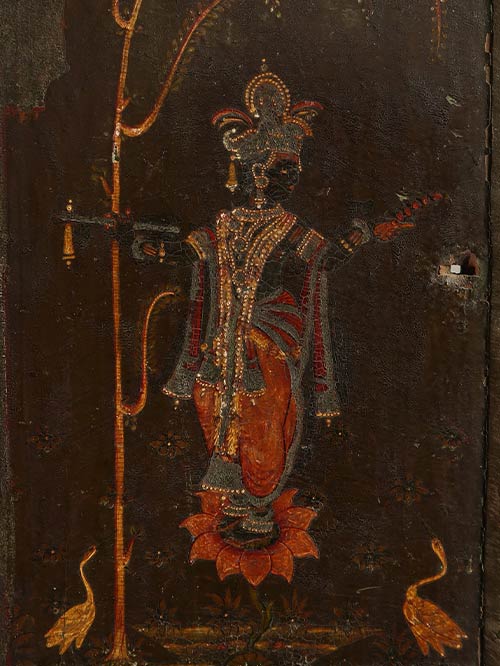
Rajasthan
Wood, polychromed
A beautiful pair of painted shutters from a household shrine. The shutter on the left depicts Krishna as Venugopala, standing on a lotus blossom upon a lake. Opposite him, Radha stands upon her own lotus, heavily bejewelled. She offers Krishna the floral garland which she holds. The nearby swans look upon the resplendent figures.
One of the most abiding images in Indian art is that of Krishna the flautist standing with his legs crossed at the ankles and playing the flute. He wears a tall decorative mukuta or crown, a dhoti and various necklaces, bangles and anklets. While other cowherders f Braj hold a shepherd’s staff, Krishna’s staff is also his flute. He, however does not play upon it to please the cows, but to charm the gopis or cowherdesses. Radha is of the Gopis of Vrindavan, who became a central figure of Vaishnava theology and she is considered to be Krishna’s favourite gopi. Radha’s selfless devotion to Krishna is regarded as a model for devotees, and she is also seen as the intermediary between man and God. According to other interpretations, Radha’s love for Krishna symbolizes the human soul’s yearning for God.
Size (cms): 51(H) x 53(W) x 10(D)
Size (inches): 20(H) x 21(W) x 4(D)
-
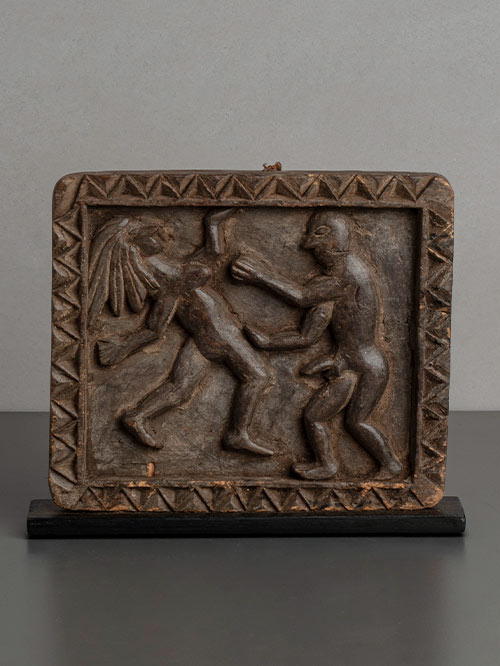
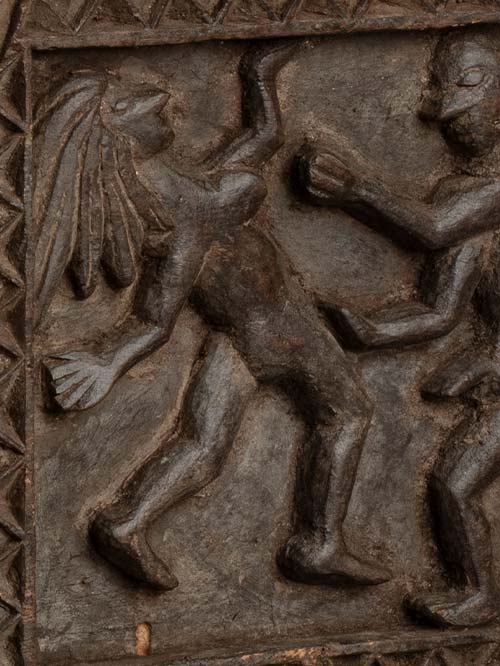
Jharkhand (Central India)
Wood
A stylised wooden panel depicting an erotic scene from the side of a Santhal Wedding Palanquin (Rahi).
The Santhals are the largest tribal community living in the Indian states of Bihar, Orissa, and West Bengal, with a minority in neighboring Bangladesh and Nepal. Marriage holds significant importance in the Santhal tribe, marked by elaborate religious and social rituals that reflect the bride and groom’s social status. A traditional aspect of the Santhal wedding ceremony involves the bride being carried in a large wicker basket or, in wealthier families, a palanquin known as a rahi.
Size (cms): 18(H) x 22(W) x 5(D)
Size (inches): 7(H) x 8.5(W) x 2(D)
-
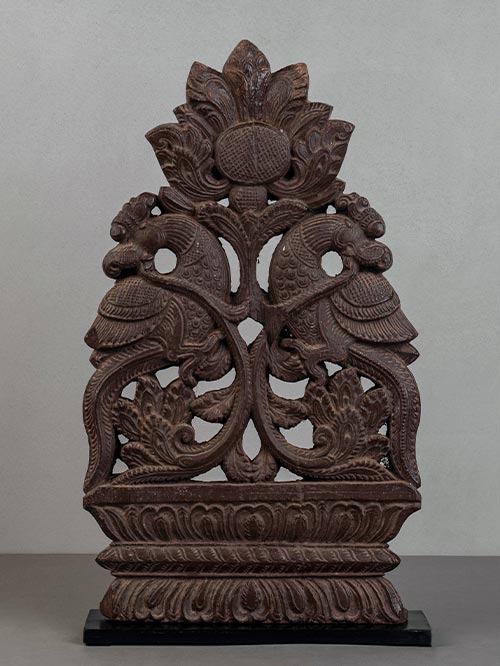
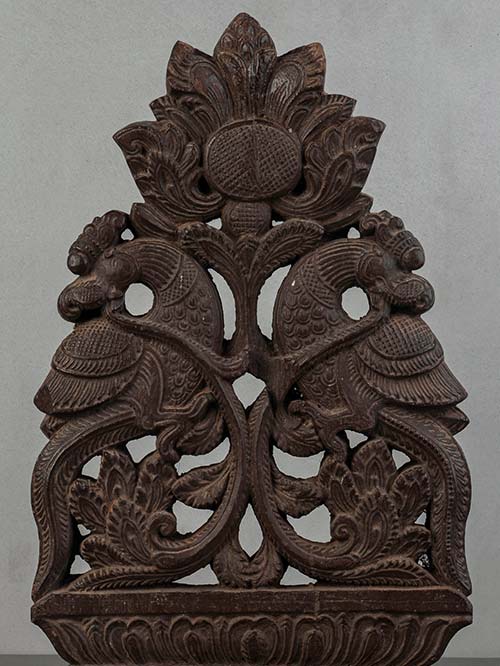
Mysore (Karnataka)
Wood
This unusual pierced panel portrays a pair of mythical Sharabhas perched atop swirling foliage, resting on a double lotus base. The mythical creatures, half-lion and half-bird, are delicately carved with scaly bodies and attractive patterned plumage. Their mouths are depicted spewing vegetation.
In Hindu mythology, Sharabha’s are a composite beast, part-lion and part-bird. Within Sanskrit literature, it initially appeared as an aggressive beast that roamed hilly and forest areas, clearing entire valley’s with a single jump. The mythological creature was later associated with Shaivism, appearing within some Puranic texts as a powerful incarnation of Shiva who assumes the form to pacify Narasimha – the fierce man-lion avatar of Vishnu worshipped by Vaishnava sect. Within Buddhist theology, Sharabha appears in Jataka Tales as a previous birth of the Buddha.
Size (cms): 50(H) x 29(W) x 9(D)
Size (inches): 19.5(H) x 11.5(W) x 3.5(D)
-
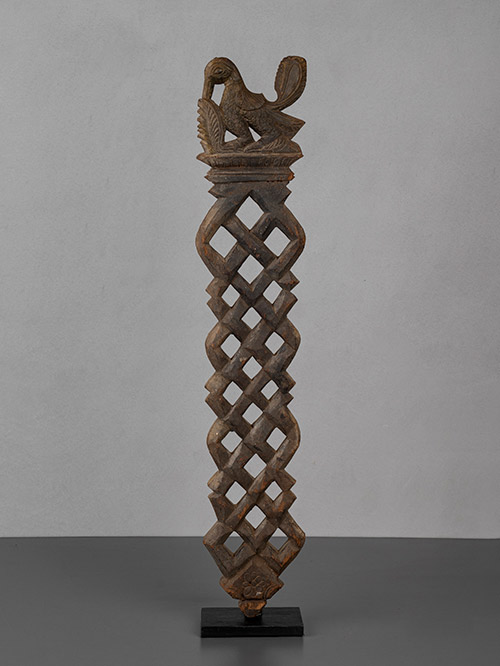

Chettinad (Tamil Nadu)
Wood
A decorative wooden spoon and ladle holder (agapai koodu) from the Chettinad region of Tamil Nadu. The knotted spoon holder has a latticed design with diamond shaped cutouts to balance the utensils. The panel is crowned with a finial depicting a hamsa bird gracefully pecking on a leafy stem
Chettinad is an area situated near the temple town of Madurai, where are large number of ornate mansions were constructed in the mid-nineteenth and early twentieth century by the Nattukottai or Nagarathar Chettiars, a traditional merchant group of traders and financiers. The Chettiars made their fortune as traders and agents of credit in Burma, Malaysia and Indonesia during the nineteenth century and returned with their profits to India, where they began constructing the elaborate mansions to proclaim their position within society. By 1945, with the rise of Nationalism through South-east Asia and looming Indian independence, the Chettiars sold their foreign interests, and returned to India to try their luck in business. As a result many of the families established new residences across the country, leaving many of their ancestral properties unused. Consequently by the 1960s and 70s, many of the Chettinad mansions, unable to raise sufficient funds for repairs, fell into decay. Many of the mansions were sold or dismantled as a result.
Size (cms): 71(H) x 14(W) x 9(D)
Size (inches): 28(H) x 5.5(W) x 3.5(D)
-

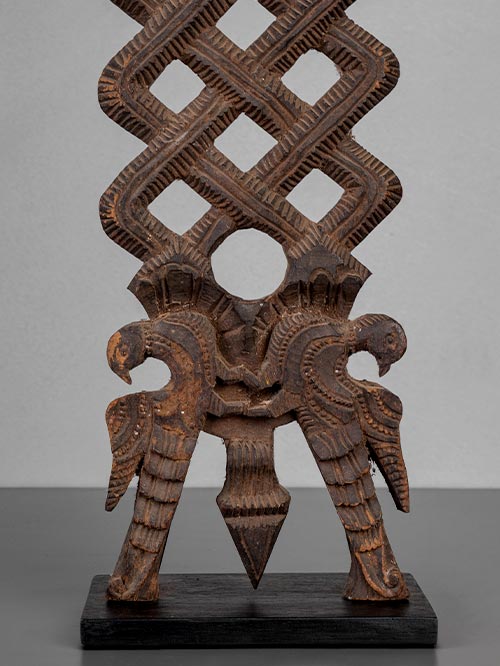
Chettinad (Tamil Nadu)
Wood
A decorative wooden spoon and ladle holder (agapai koodu) from the Chettinad region of Tamil Nadu. The knotted spoon holder has a latticed design with diamond shaped cutouts to balance the utensils. The panel is crowned with a finial shaped like a miniature temple complex, while at the bottom, a pair of parrots form an arched support.
Chettinad is an area situated near the temple town of Madurai, where are large number of ornate mansions were constructed in the mid-nineteenth and early twentieth century by the Nattukottai or Nagarathar Chettiars, a traditional merchant group of traders and financiers. The Chettiars made their fortune as traders and agents of credit in Burma, Malaysia and Indonesia during the nineteenth century and returned with their profits to India, where they began constructing the elaborate mansions to proclaim their position within society. By 1945, with the rise of Nationalism through South-east Asia and looming Indian independence, the Chettiars sold their foreign interests, and returned to India to try their luck in business. As a result many of the families established new residences across the country, leaving many of their ancestral properties unused. Consequently by the 1960s and 70s, many of the Chettinad mansions, unable to raise sufficient funds for repairs, fell into decay. Many of the mansions were sold or dismantled as a result.
Size (cms): 83(H) x 16.5(W) x 11(D)
Size (inches): 32.5(H) x 6.5(W) x 4.5(D)
-
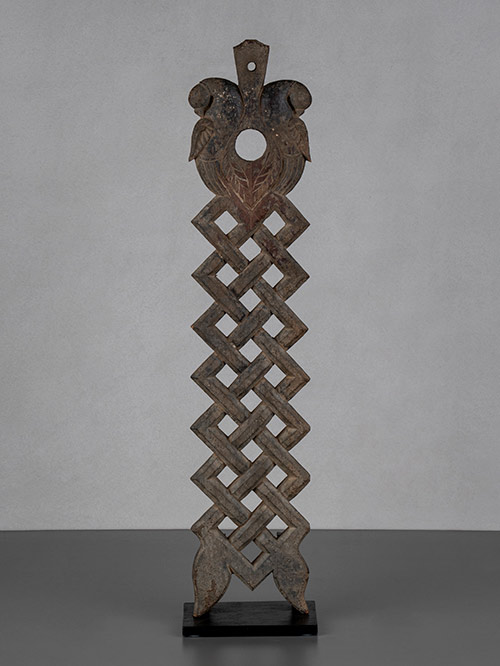
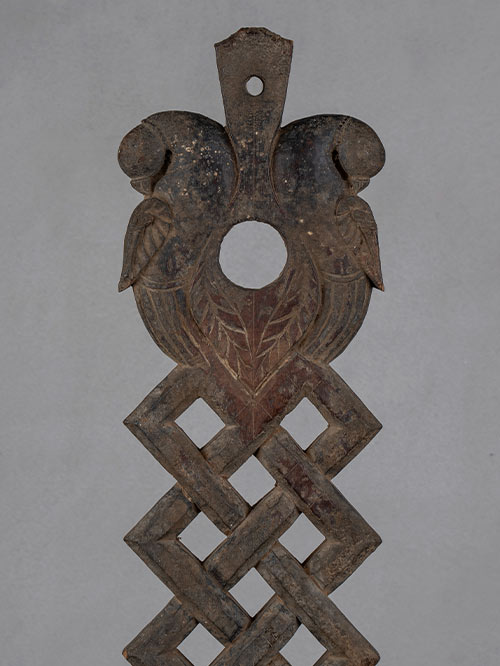
Chettinad (Tamil Nadu)
Wood
A decorative wooden spoon and ladle holder (agapai koodu) from the Chettinad region of Tamil Nadu. The knotted spoon holder has a latticed design with diamond shaped cutouts to balance the utensils. The panel is crowned with a finial depicting a pair of symmetrical parrots.
Chettinad is an area situated near the temple town of Madurai, where are large number of ornate mansions were constructed in the mid-nineteenth and early twentieth century by the Nattukottai or Nagarathar Chettiars, a traditional merchant group of traders and financiers. The Chettiars made their fortune as traders and agents of credit in Burma, Malaysia and Indonesia during the nineteenth century and returned with their profits to India, where they began constructing the elaborate mansions to proclaim their position within society. By 1945, with the rise of Nationalism through South-east Asia and looming Indian independence, the Chettiars sold their foreign interests, and returned to India to try their luck in business. As a result many of the families established new residences across the country, leaving many of their ancestral properties unused. Consequently by the 1960s and 70s, many of the Chettinad mansions, unable to raise sufficient funds for repairs, fell into decay. Many of the mansions were sold or dismantled as a result.
Size (cms): 71(H) x 16.5(W) x 12(D)
Size (inches): 28(H) x 6.5(W) x 4.5(D)
-
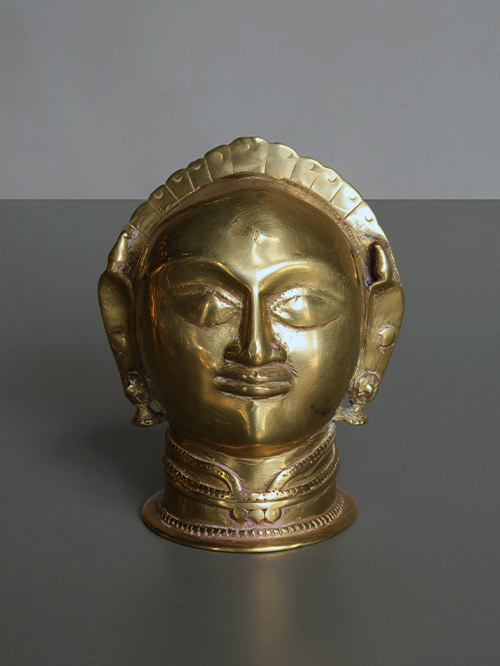
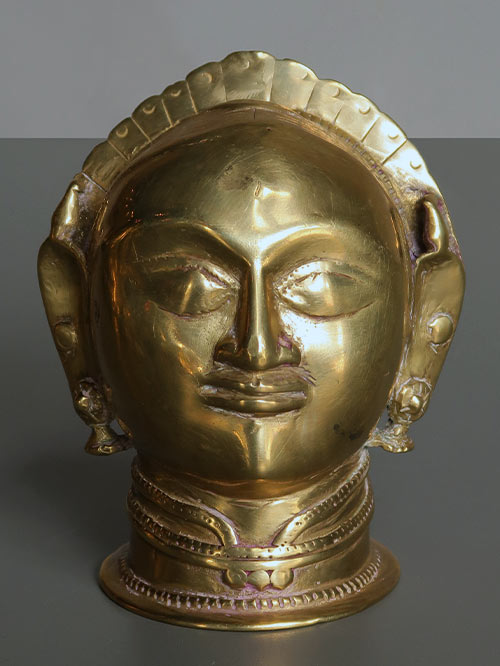
Maharashtra/Karnataka
Brass
An attractive diminutive Gauri head with finely modelled features including necklaces, hair and ear ornaments as well as an engraved crown. Gauri is the name of a benevolent goddess, consort of Shiva or Varuna. Connected with the rains, she is reputed to be the source of the world and the embodiment of motherhood.
In household shrines in Maharashtra and Karnataka, the deity was considered a privileged house guest and treated accordingly. Images of the god were bathed, clothed, bejeweled and nourished in preparation for puja and darshan. Often elaborate turbans were placed on the head and bound by the finest cloths usually in the auspicious deep red colour. In some cases the masks were mounted on a wooden framework and covered with cloths. Sometimes separate metal cast arms and legs were attached to the figure, thus providing a more realistic depiction of the deity.
Size (cms): 12(H) x 9(W) x 8(D)
Size (inches): 4.5(H) x 3.5(W) x 3(D)
-
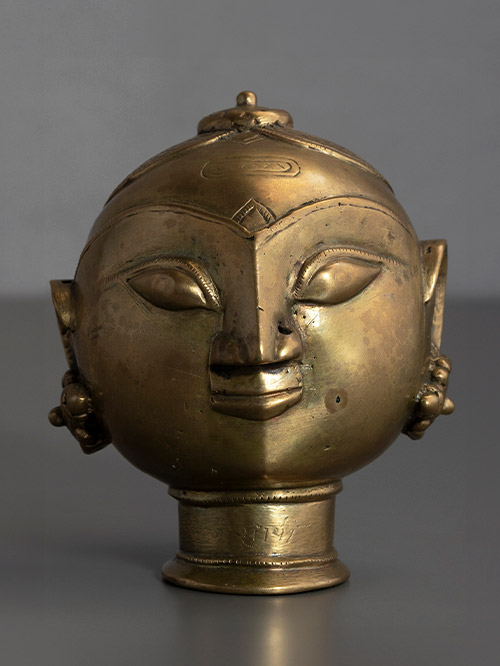
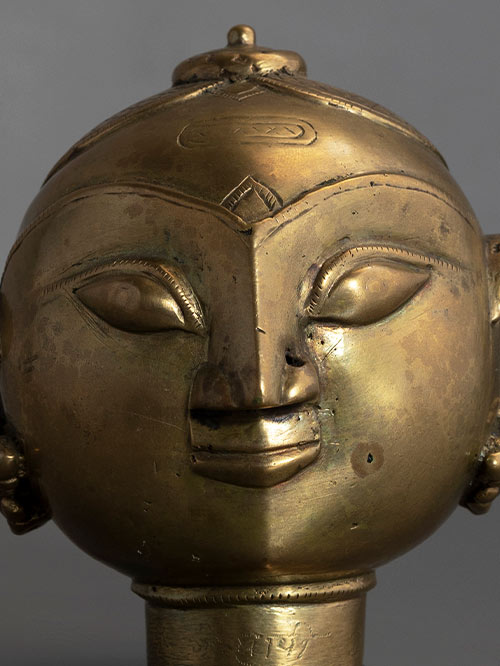
Maharashtra/ Karnataka
Brass alloy
Gauri is the name of a benevolent goddess, consort of Shiva or Varuna. Connected with the rains, she is reputed to be the source of the world and the embodiment of motherhood. She is depicted as a two-or four-armed woman of fair complexion, carrying in her upper arms prayer beads and a water pot, while the lower hands are in Abhaya and Varadamudra. She may also carry a mirror, a fish, a lotus, a trident and a floral wreath. Her mount is the godhika (iguana). Occasionally she is shown riding either a lion, a wolf, a pig or a goose.
Size (cms): 12(H) x 10(W) x 10(D)
Size (inches): 4.5(H) x 4(W) x 4(D)
-
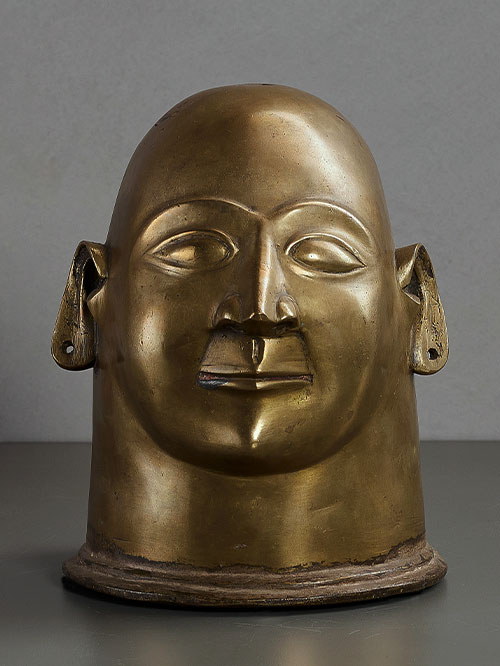

Karnataka (South India)
Brass alloy
A very unusual Gauri head with large almond shaped eyes, pierced ears and a smooth rounded head.
Gauri is the name of a benevolent goddess, consort of Shiva or Varuna. Connected with the rains, she is reputed to be the source of the world and the embodiment of motherhood. She is depicted as a two-or four-armed woman of fair complexion, carrying in her upper arms prayer beads and a water pot, while the lower hands are in Abhaya and Varadamudra. She may also carry a mirror, a fish, a lotus, a trident and a floral wreath. Her mount is the godhika (iguana). Occasionally she is shown riding either a lion, a wolf, a pig or a goose.
Size (cms): 26.75(H) x 22.8(W) x 20.3(D)
Size (inches): 10.5(H) x 9(W) x 8(D)
-

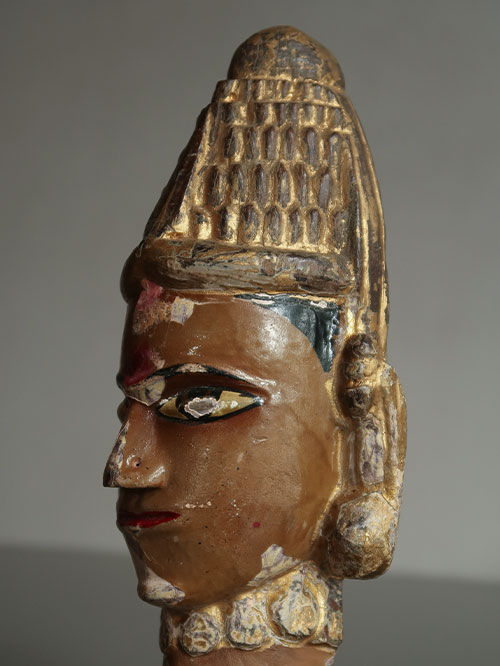
Konkan region (Karnataka)
Wood, polychromed
Gauri is the name of a benevolent goddess, consort of Shiva or Varuna. Connected with the rains, she is reputed to be the source of the world and the embodiment of motherhood. She is depicted as a two-or four-armed woman of fair complexion, carrying in her upper arms prayer beads and a water pot, while the lower hands are in Abhaya and Varadamudra. She may also carry a mirror, a fish, a lotus, a trident and a floral wreath. Her mount is the godhika (iguana). Occasionally she is shown riding either a lion, a wolf, a pig or a goose.
Size with stand (cms): 9.5(H) x 5(W) x 3(D)
Size with stand (inches): 24.5(H) x 13(W) x 7.5(D)
-

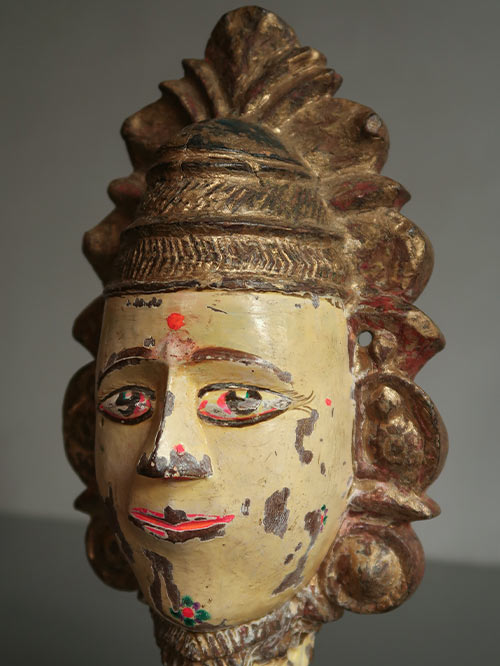
Konkan region (Karnataka)
Wood, polychromed
Gauri is the name of a benevolent goddess, consort of Shiva or Varuna. Connected with the rains, she is reputed to be the source of the world and the embodiment of motherhood. She is depicted as a two-or four-armed woman of fair complexion, carrying in her upper arms prayer beads and a water pot, while the lower hands are in Abhaya and Varadamudra. She may also carry a mirror, a fish, a lotus, a trident and a floral wreath. Her mount is the godhika (iguana). Occasionally she is shown riding either a lion, a wolf, a pig or a goose.
Size with stand (cms): 29.5(H) x 16(W) x 7.5(D)
Size with stand (inches): 11.5(H) x 6.5(W) x 3(D)
-
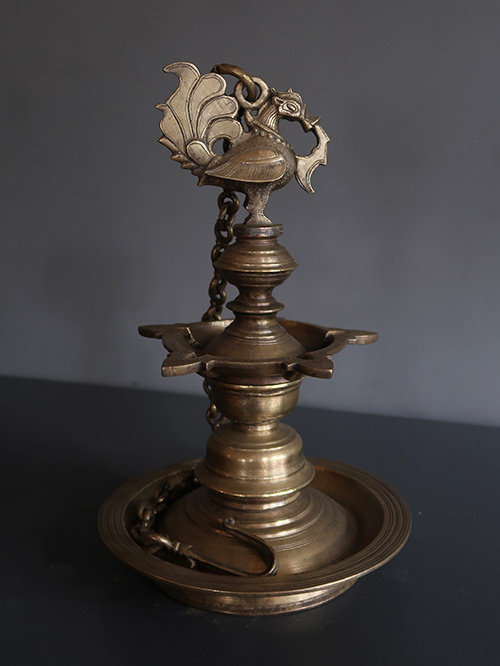
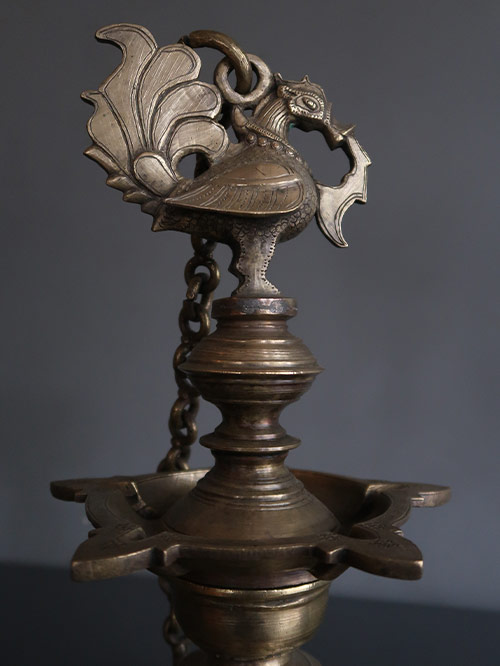
Kerala
Brass Alloy
A fine two-tiered temple lamp with a Hamsa (goose) final. The upper circular reservoir with five lotus petal shaped spouts in each of which a wick would be placed.
The Hamsa is a familiar motif in Indian art, literature, sculpture and textiles. It is an aquatic bird that resembles a goose or a swan. It is reputed to eat pearls and to be able to separate milk from water. The Hamsa is seen as a symbol of purity, detachment, divine knowledge, cosmic breath (prana) and the highest spiritual accomplishment.
Hanging lamps, sometimes called chain lamps, may have originated from as far afield as Greece or Rome, entering South Asia from the early ports of Arikamedu and Mammalapuram (both near present day Chennai). Used primarily in a temple context, the chain lamp cast its light broadly, and in so doing extended spiritual agency. Much like other lamp types, it served as a backdrop to images placed before it on the altar. A group of hanging temple lamps within the temple would have generated a tremendous play of light and shadows over walls, ceilings and floors.
Size(cms): 35 (H w/o Chain) x 21.5 (Diameter), 94 (H with Chain)
Size(inches): 13.75 (H w/0 Chain ) x 8.5 (Diameter), 37 (H with Chain)

































